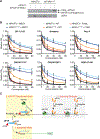Rocaglates Induce Gain-of-Function Alterations to eIF4A and eIF4F
- PMID: 32101697
- PMCID: PMC7077502
- DOI: 10.1016/j.celrep.2020.02.002
Rocaglates Induce Gain-of-Function Alterations to eIF4A and eIF4F
Abstract
Rocaglates are a diverse family of biologically active molecules that have gained tremendous interest in recent years due to their promising activities in pre-clinical cancer studies. As a result, this family of compounds has been significantly expanded through the development of efficient synthetic schemes. However, it is unknown whether all of the members of the rocaglate family act through similar mechanisms of action. Here, we present a comprehensive study comparing the biological activities of >200 rocaglates to better understand how the presence of different chemical entities influences their biological activities. Through this, we find that most rocaglates preferentially repress the translation of mRNAs containing purine-rich 5' leaders, but certain rocaglates lack this bias in translation repression. We also uncover an aspect of rocaglate mechanism of action in which the pool of translationally active eIF4F is diminished due to the sequestration of the complex onto RNA.
Keywords: eIF4A; eIF4F; interfacial inhibitor; rocaglates; translation initiation.
Copyright © 2020 The Author(s). Published by Elsevier Inc. All rights reserved.
Conflict of interest statement
Declaration of Interests J.C., W.Z., J.A.P., and J.P. have filed a US provisional patent application on the use of amidino- and amino-rocaglates as novel translation inhibitors and anticancer agents. All other authors declare no competing interests.
Figures




References
Publication types
MeSH terms
Substances
Grants and funding
LinkOut - more resources
Full Text Sources
Other Literature Sources
Molecular Biology Databases
Research Materials
Miscellaneous

